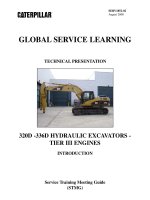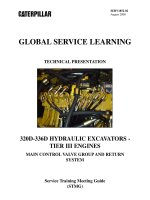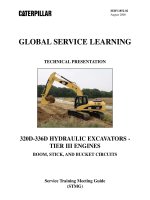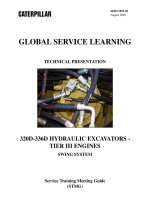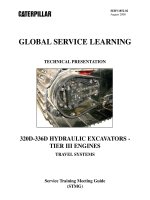D 5048 20a
Bạn đang xem bản rút gọn của tài liệu. Xem và tải ngay bản đầy đủ của tài liệu tại đây (265.26 KB, 10 trang )
This international standard was developed in accordance with internationally recognized principles on standardization established in the Decision on Principles for the
Development of International Standards, Guides and Recommendations issued by the World Trade Organization Technical Barriers to Trade (TBT) Committee.
Designation: D5048 − 20a
Standard Test Method for
Measuring the Comparative Burning Characteristics and
Resistance to Burn-Through of Solid Plastics Using a
125-mm Flame1
This standard is issued under the fixed designation D5048; the number immediately following the designation indicates the year of
original adoption or, in the case of revision, the year of last revision. A number in parentheses indicates the year of last reapproval. A
superscript epsilon (´) indicates an editorial change since the last revision or reapproval.
priate safety, health, and environmental practices and determine the applicability of regulatory limitations prior to use.
See 6.1.1 for a specific hazard statement.
1.8 This international standard was developed in accordance with internationally recognized principles on standardization established in the Decision on Principles for the
Development of International Standards, Guides and Recommendations issued by the World Trade Organization Technical
Barriers to Trade (TBT) Committee.
1. Scope*
1.1 This fire-test-response standard contains a test method
for small-scale laboratory procedures to be used to determine
the relative burning characteristics and the resistance to burnthrough of plastics using small bar and plaque specimens
exposed to a 125-mm (500-W nominal) flame.
1.1.1 Use Test Method D3801 for assessing comparative
burning characteristics of solid plastics in a vertical position.
NOTE 1—This test method is equivalent to IEC 60695-11-20 and UL 94
(Section 9).
2. Referenced Documents
1.2 The results are intended to serve as a preliminary
indication of their acceptability with respect to flammability for
a particular application. The final acceptance of the material is
dependent upon its use in the end-product that conforms with
the standards applicable to such end-product.
2.1 ASTM Standards:2
D883 Terminology Relating to Plastics
D3801 Test Method for Measuring the Comparative Burning
Characteristics of Solid Plastics in a Vertical Position
D5025 Specification for Laboratory Burner Used for SmallScale Burning Tests on Plastic Materials
D5207 Practice for Confirmation of 20–mm (50–W) and
125–mm (500–W) Test Flames for Small-Scale Burning
Tests on Plastic Materials
E176 Terminology of Fire Standards
E456 Terminology Relating to Quality and Statistics
E691 Practice for Conducting an Interlaboratory Study to
Determine the Precision of a Test Method
E2935 Practice for Conducting Equivalence Tests for Comparing Testing Processes
1.3 The classification system described in Appendix X1 is
intended for quality assurance and the preselection of component materials for products.
1.4 If found to be appropriate, it is suitable to apply the
requirements to other nonmetallic materials. Such application
is outside the scope of this technical committee.
1.5 Fire testing is inherently hazardous. Adequate safeguards for personnel and property shall be employed in
conducting these tests.
1.6 This standard is used to measure and describe the
response of materials, products, or assemblies to heat and
flame under controlled conditions, but does not by itself
incorporate all factors required for fire hazards or fire risk
assessment of materials, products, or assemblies under actual
fire conditions.
1.7 This standard does not purport to address all of the
safety concerns, if any, associated with its use. It is the
responsibility of the user of this standard to establish appro-
2.2 IEC Standard:3
IEC 60695-11-20 Fire Hazard Testing-Part 11-20: Test
Flames - 500 W Flame Test Methods
2.3 ISO Standards:4
ISO 13943 Fire Safety—Vocabulary
2
For referenced ASTM standards, visit the ASTM website, www.astm.org, or
contact ASTM Customer Service at For Annual Book of ASTM
Standards volume information, refer to the standard’s Document Summary page on
the ASTM website.
3
Publications of the International Electrotechnical Commission (IEC) are
available from American National Standards Institute (ANSI), 25 W. 43rd St., 4th
Floor, New York, NY 10036, .
4
Available from American National Standards Institute (ANSI), 25 W. 43rd St.,
4th Floor, New York, NY 10036, .
1
This test method is under the jurisdiction of ASTM Committee D20 on Plastics
and is the direct responsibility of Subcommittee D20.30 on Thermal Properties.
Current edition approved Sept. 1, 2020. Published September 2020. Originally
approved in 1990. Last previous edition approved in 2020 as D5048 – 20. DOI:
10.1520/D5048-20A.
*A Summary of Changes section appears at the end of this standard
Copyright © ASTM International, 100 Barr Harbor Drive, PO Box C700, West Conshohocken, PA 19428-2959. United States
1
D5048 − 20a
2.4 UL Standards:5
UL 94 Standard for Tests for Flammability of Plastic Materials for Parts in Devices and Appliances
test results for plaques also indicate whether or not the
specified flame will burn through a material.
5.2 The test is capable of assessing the effects of material
thickness, colors, additives, deterioration, and possible loss of
volatile components on afterflame and afterglow.
3. Terminology
3.1 Definitions—For definitions of terms relating to plastics,
the definitions in this test method are in accordance with
Terminology D883. For terms relating to fire, the definitions in
this test method are in accordance with Terminology E176 and
ISO 13943. In case of conflict, the definitions given in
Terminology E176 shall prevail. For terms relating to precision
and bias and associated issues, the terms used in this test
method are in accordance with the definitions in Terminology
E456.
5.3 The burning characteristics is found to vary with thickness. Test data shall be compared only with data for material of
the same thickness.
5.4 The results serve as a reference for comparing the
relative performance of materials and can be an aid in material
selection.
5.5 In this test method, the specimens are subjected to one
or more specific laboratory test conditions. If different test
conditions are substituted or the end-use conditions are
changed, it will not always be possible by or from this test
method to predict changes in the fire-test-response characteristics measured. Therefore, the results are valid only for the
fire-test-exposure conditions described in this test method.
3.2 Definitions of Terms Specific to This Standard:
3.2.1 flame-application time—the time in seconds that the
flame from the burner is in contact with the specimen.
3.2.2 flaming material—flaming drips or particles from the
specimen which ignite the dry, absorbent 100 % surgical cotton
placed 300 6 10 mm below the test specimen.
3.2.3 afterflame—persistence of flaming of a material, after
the ignition source has been removed.
3.2.4 afterflame time—the length of time for which a material continues to flame, under specified conditions, after the
ignition source has been removed.
3.2.5 afterglow—persistence of glowing of a material, after
cessation of flaming or, if no flaming occurs, after removal of
the ignition source.
3.2.6 afterglow time—the length of time for which a material continues to glow under specified test conditions, after the
ignition source has been removed or cessation of flaming, or
both.
3.2.7 burn-through—a hole produced in the plaque specimen.
3.2.8 flame—to undergo combustion in the gaseous phase
with emission of light.
3.2.9 glow—visible light, other than from flaming, emitted
by solid undergoing combustion.
NOTE 2—The amount of oxygen available to support combustion is
important for the conduct of flame tests. When burning times are
prolonged, chamber sizes less than 1.0 m3 do not consistently provide
accurate results.
NOTE 3—Placing a mirror in the hood, to provide a rear view of the test
specimen, has been found useful.
4. Summary of Test Method
6.2 Burner, constructed in accordance with Specification
D5025.
6. Apparatus
6.1 Test Chamber, an enclosure or laboratory hood with a
minimum capacity of 0.5 m3, free of induced or forced draft
during testing. The use of an enclosed laboratory hood with a
heat-resistant glass window is recommended. If a draft is noted
with the exhaust fan off, further measures are needed to
eliminate the draft, such as adding a positive closing damper.
The inside surfaces of the chamber shall be of a dark color.
When a light meter, facing towards the rear of the chamber, is
positioned in place of the test specimen, the light level shall be
less than 20 lx.
6.1.1 Warning—Products of combustion are toxic. An exhaust fan shall be provided for removing the products of
combustion immediately after the test.
4.1 Sets of 13 6 0.5 mm by 125 6 5 mm bar specimens and
150 6 5 mm by 150 6 5 mm plaque specimens are subjected
to a 125 mm flame with a 40 6 2 mm inner blue cone, for five
5-second flame applications. The afterflame plus afterglow
time for the bar specimen is recorded after removal of the fifth
flame application. Information is recorded on whether or not
flaming material drips from the specimens, and whether or not
the plaque specimens exhibit burn-through.
6.3 Ring Stand, with a clamp or the equivalent, adjustable
for vertical positioning of bar specimens and horizontal positioning of plaque specimens.
6.4 Gas Supply—Use technical-grade methane gas (min
98 % pure) as the fuel with suitable regulator and meter for
uniform gas flow.
6.4.1 The use of natural gas having an energy density of 37
6 1 MJ/m3 (1000 Btu/ft3) has been found to provide similar
results but is not acceptable as the referee gas in cases of
dispute.
6.4.2 The use of other fuel gases, such as butane, propane or
acetylene is not suitable because they have higher energy per
unit volume.
5. Significance and Use
5.1 The test results present afterflame plus afterglow times,
in seconds, for a material under the conditions of the test. The
6.5 Burner Mounting Fixture, a fixture capable of positioning the burner at an angle of 20 6 5° from the vertical.
5
Available from Underwriters Laboratories (UL), 2600 N.W. Lake Rd., Camas,
WA 98607-8542, .
2
D5048 − 20a
corresponding to the highest level and that corresponding to no
pigment. Testing as follows is required and is likely to cover
the range of flammability performance:
(a) contain no pigments (natural)
(b) contain the highest level of organic pigments
(c) contain the highest level of inorganic pigments
(d) contain the highest level of carbon black (if carbon
black is one of the additives in a pigment package)
(e) contain pigments which are known to adversely affect
flammability characteristics
6.6 Timing Device, stop watch or other suitable timing
device capable of timing to the nearest 0.5 seconds.
6.7 Cotton, a supply of dry, absorbent 100 % surgical
cotton.
6.8 Desiccator, containing anhydrous calcium chloride or
other suitable drying agent, capable of maintaining a relative
humidity not exceeding 20 % at 23 6 2°C.
6.9 Conditioning Room or Chamber, capable of being maintained at 23 6 2°C and a relative humidity of 50 6 10 %.
6.10 Conditioning Oven, a full-draft circulating air oven
capable of being maintained at 70 6 2°C.
9. Conditioning
9.1 Condition one set of five bar specimens and three plaque
specimens for at least 48 h at a temperature of 23 6 2°C and
a relative humidity of 50 6 10 % prior to testing.
6.11 Micrometer, capable of being read to 0.01 mm.
6.12 Weighing Scale or Balance, having an accuracy and
resolution of 0.01 g.
9.2 Condition a second set of five bar specimens and three
plaque specimens in a circulating air oven for a duration of 168
h at 70 6 2°C, and then cool in a desiccator over anhydrous
calcium chloride for at least 4 h at room temperature prior to
testing. The desiccator should be capable of maintaining a
relative humidity not exceeding 20 % at 23 6 2°C.
6.13 Flame Clearance Gauge, (optional) used to determine
flame position on specimen during testing. See Appendix X2.
7. Sampling
7.1 Unless otherwise agreed upon, the test specimen material shall be sampled in accordance with good statistical
practice.
9.3 Upon removal from the conditioning environment,
specimens shall be tested within 30 minutes.
9.4 All specimens shall be tested in a laboratory atmosphere
of 15 to 35°C and ≤75 % relative humidity.
8. Test Specimens
8.1 The standard bar specimen shall be 13 6 0.5 by 125 6
5 mm. The standard plaque specimen shall be 150 6 5 by 150
6 5 mm. Bar and plaque specimens shall be in the thickness
appropriate to the objectives of the determination. Do not use
this test method for materials thicker than 13 mm.
9.5 Cotton shall be conditioned in the desiccator for at least
24 hours prior to use. Once removed from the desiccator, the
cotton shall be used within 30 minutes.
10. Procedure
8.2 Surfaces must be smooth and unbroken. Corner radius
shall not exceed 1.3 mm. After any cutting operation, remove
all dust and any particles from the surface; cut edges are to
have a smooth finish.
10.1 Procedure A—Test of Bar Specimens:
10.1.1 Conduct the burning test in a chamber, enclosure, or
laboratory hood free of induced or forced draft.
10.1.2 Support a specimen from the upper 6 mm of the
specimen, with the longitudinal axis vertical, by the clamp on
the ring stand so that the lower end of the specimen is 300 6
10 mm above a horizontal layer of cotton, approximately 50 by
50 mm, thinned to a maximum uncompressed thickness of 6
mm, maximum weight of 0.05 g to 0.08 grams.
8.3 Since the results of tests carried out on test specimens of
different colors, thicknesses, densities, molecular masses, directions of orientation, or containing different levels or
amounts of additives, fillers or reinforcements are potentially
different, the additional considerations indicated in sections
8.3.1 through 8.3.2 shall apply.
8.3.1 When conducting tests on test specimens at the
minimum and maximum densities, melt flows and levels of
fillers or of reinforcements, the test results shall only be
considered representative of the complete range, if the results
yield the same burning characteristics, including the same
flame test classification.
8.3.2 If the burning characteristics, including the flame test
classification, are not essentially the same for all specimens
representing the range tested, the test results shall be considered to apply only to those materials for which the actual color,
thickness, density, molecular mass, melt flow characteristics
and level of additives, fillers and or reinforcements have been
tested. Additional specimens shall be tested for intermediate
ranges of each property.
NOTE 4—To form the horizontal layer, it is acceptable to pull a small
portion (approximately 13 by 25 mm of cotton from the supply with the
fingers and then thin and spread the cotton into a 50 by 50-mm square
having a free-standing thickness of 6 mm.
10.1.3 Adjust the methane gas supply to the burner to
produce a gas flow rate of 965 6 30 mL/min with a back
pressure of 125 6 25 mm water. Place the burner remote from
the specimen, ignite, and adjust it so that when the burner is in
a vertical position, the overall height of the flame is 125 6 10
mm, and the height of the inner blue cone is 40 6 2 mm.
Support the burner on the inclined plane of the mounting
fixture so that the burner tube is positioned at 20 6 5° from the
vertical (see Fig. 1).
10.1.4 Apply the flame to one of the lower corners of the
specimen at an angle of 20 6 5° from the vertical, so that the
tip of the inner blue cone is within 0 to 3 mm of the specimen
edge without impinging into the specimen (see Fig. 2). Apply
the flame for 5 6 0.5 seconds and then remove the flame for
8.4 The range of flammability characteristics is likely to be
affected by the pigments and for each individual type of
pigment, the flammability is likely to range between that
3
D5048 − 20a
FIG. 1 Burner Mounting Block—Example
FIG. 2 Procedure A—Test of Bar Specimens
5 6 0.5 seconds. Repeat this operation until the specimen has
been subjected to five applications of the test flame. After each
flame application, immediately withdraw the burner a sufficient
distance so that there is no thermal effect on the bar test
specimen.
and maintaining in position throughout the test.
10.1.4.1 If the specimen drips particles, shrinks, distorts or
elongates during the test, move the burner so that the tip of the
inner blue cone is within 0 mm – 3 mm of the corner of the bar
test specimen nearest to the burner, ignoring any strings of
molten material (see Fig. 3).
NOTE 5—A flame clearance gauge, pictured in Fig. X2.1, has been
found helpful in correctly applying the flame in accordance with 10.1.4
4
D5048 − 20a
The examples illustrate the position of the flame at the beginning of a flame application following test specimen deformation.
FIG. 3 Examples of Flame Application
10.1.6 Calculate the arithmetic mean of the afterflame time
and afterflame plus afterglow times for each set of five
specimens.
NOTE 6—Annex A of IEC 60695-11-20 is to be referenced for guidance.
10.1.4.2 When necessary, hand-hold the burner and fixture
to accomplish this. After the fifth removal of the test flame,
record, in seconds, the total afterflame time and afterflame plus
afterglow times. Note whether or not the specimen dripped
flaming particles that ignited the cotton.
10.1.5 Repeat the procedure in 10.1.2 – 10.1.4 on the
remaining specimens for each set, one set conditioned as
described in 9.1 and one set conditioned as described in 9.2.
10.2 Procedure B—Test of Plaque Specimens:
10.2.1 Proceed as in 10.1.1.
10.2.2 Support a plaque specimen at its edges so that it is
horizontal, using a clamp and ring stand or other equivalent
means.
5
D5048 − 20a
11.1.3 Duration of afterflame time after fifth flame application (t1).
11.1.4 Duration of afterglow time after fifth flame application (t2).
11.1.5 Total afterflame time and afterflame (t1) plus afterglow (t2) times after the fifth flame application for each
specimen,
11.1.6 Arithmetic means of afterflame time and afterflame
plus afterglow times for each specimen set,
11.1.7 Whether or not any of the specimens drip flaming
particles which ignite the cotton swatch, and
11.1.8 Whether or not any of the plaques burn through after
the fifth flame application.
10.2.3 Proceed as in 10.1.3.
10.2.4 Apply the flame to the center of the bottom surface of
the plaque at an angle of 20 6 5° from the vertical so that the
tip of the inner blue cone is within 0 to 3 mm of the plaque
surface, without impinging into the specimen (see Fig. 4).
Apply the flame for 5 6 0.5 seconds and then remove the flame
for 5 6 0.5 seconds. Repeat this operation until the plaque has
been subjected to five applications of the test flame. After each
flame application, immediately withdraw the burner a sufficient
distance so that there is no thermal effect on the bar test
specimen.
10.2.4.1 If necessary, hand-hold the burner and fixture so
that the tip of the inner blue cone maintains the required
distance. After the fifth removal of the test flame, note whether
or not the flame burned through the plaque. Flame penetration
shall be defined as any visible flame observed on the top
surface of the plaque during the test. In addition, no opening
greater than 3 mm shall appear after the test and the sample has
cooled for 30 seconds.
10.2.5 Repeat the procedure in 10.2.2 – 10.2.4 on the
remaining plaques for each set, one set conditioned as described in 9.1 and one set conditioned as described in 9.2.
12. Precision and Bias
12.1 The precision of this test method is based on an
interlaboratory study conducted in 1988. Thirteen laboratories
tested seven different materials. The tests were conducted in
accordance with Procedure A. Every “test result” represents the
average of five individual determinations. Each laboratory was
asked to submit three replicate test results, from a single
operator, for each material. Practice E691 was followed for the
design and analysis of data.
11. Report
12.2 Warning—The data in Tables 1 and 2 shall not be
rigorously applied to acceptance or rejection of material, as
those data are specific to the interlaboratory study and are not
necessarily representative of other lots, conditions, materials,
or laboratories. Users of this test method shall apply the
principles outlined in Practice E691 to generate data specific to
their laboratory and materials, or between specific laboratories.
11.1 The complete report shall include the following information:
11.1.1 Material Identification—Generic description,
manufacturer, commercial designation, lot number, and color.
11.1.1.1 Report the test specimen thickness and any other
special characteristics not identified above.
11.1.2 Conditioning or Aging:
11.1.2.1 Conditioning time at 23 6 2°C, in hours, for
specimens conditioned in accordance with 9.1.
11.1.2.2 Cooling time in desiccator, in hours, for specimens
conditioned in accordance with 9.2.
12.3 Equivalence testing on numerical data from two
sources shall be conducted in accordance with E2935.
12.4 Bias—There are no recognized standards on which to
base an estimate of bias for this test method.
FIG. 4 Procedure B—Test of Plaque Specimens
6
D5048 − 20a
TABLE 1 Average Afterflame Time
MaterialA
Polybutylene Terephthalate I
Polybutylene Terephthalate II
Polyamide
Polycarbonate
Unsaturated Polyester I
Modified Polyphenylene Ether
Unsaturated Polyester II
Average Afterflame Time, s
Average Specimen
Thickness, mm
Average
Sr B
SR C
rD
RE
3.2
3.1
3.2
3.2
1.6
3.2
2.7
0.91
1.25
1.48
2.17
6.37
10.97
110.4
0.35
0.53
0.28
0.49
2.42
3.75
31.0
0.63
1.09
0.85
1.05
5.35
5.84
70.5
0.98
1.48
0.78
1.37
6.78
10.50
86.8
1.76
3.05
2.38
2.94
14.98
16.35
197.3
A
Specimens conditioned in accordance with 9.1.
Sr = Within-laboratory standard deviation of the average.
C
SR = Between-laboratory standard deviation of the average.
D
r = 2.8 Sr .
E
R = 2.8 SR .
B
TABLE 2 Average Afterflame Plus Afterglow
MaterialA
Polyamide
Polycarbonate
Unsaturated Polyester I
Modified Polyphenylene Ether
Polybutylene Terephthalate I
Polybutylene Terephthalate II
Unsaturated Polyester II
Average Afterflame Plus Afterglow
Average Specimen
Thickness, mm
Average
Sr B
SR C
rD
RE
3.2
3.2
1.6
3.2
3.2
3.1
2.7
1.57
2.23
8.18
11.04
12.13
12.52
110.5
0.36
0.47
1.99
3.75
1.97
1.02
30.9
0.93
1.01
5.43
5.80
3.54
3.16
70.3
1.01
1.32
5.57
10.50
5.52
2.86
86.5
2.60
2.83
15.20
16.24
9.91
8.85
196.8
A
Specimens conditioned in accordance with 9.1.
Sr = Within-laboratory standard deviation of the average.
SR = Between-laboratory standard deviation of the average.
D
r = 2.8 Sr .
E
R = 2.8 SR .
B
C
13. Keywords
13.1 burning characteristics; flammability; plastics; solid;
resistance to burn-through; small-scale burning tests; vertical
burning tests
APPENDIXES
(Nonmandatory Information)
X1. CLASSIFICATION SYSTEM FOR THE COMPARATIVE BURNING CHARACTERISTICS AND RESISTANCE TO BURNTHROUGH OF SOLID PLASTICS USING A125-mm FLAME
TABLE X1.1 Materials ClassificationsA
X1.1 This appendix describes a classification system that
can be used to characterize the burning behavior of solid
plastics in response to a 125-mm flame ignition source. The use
of a category designation code is optional and is determined by
examining the test results of materials tested by this test
method. Each category code represents a preferred range of
performance levels that simplifies description in material
designations or specifications and is in use by certification
bodies to determine compliance with applicable requirements.
Criteria Conditions
5VA
5VB
Individual bar specimen afterflame (t1) plus afterglow
time (t2) after the fifth flame application, s
Classified as V-0 or V-1 according to D3801?
Was the cotton indicator ignited by flaming
particles or drops from any bar specimen?
Did the flame penetrate through (burn-through)
any of the individual plaques? OR
No plaque specimens were listed?
<60
<60
yes
no
yes
no
no
yes
A
If only one specimen from a set of five bar specimens or one plaque from a set
of three plaques for a given preconditioning treatment does not comply with all
criteria for a category, another set of five bar specimens or three plaques subjected
to the same preconditioning shall be tested. All specimens or plaques from the
second set shall comply with all specified criteria for the category.
X1.2 The material shall be classified in one of the categories
shown in Table X1.1 by selecting the appropriate column using
test results to answer the conditional questions posed.
X1.3 Materials classified 5VA or 5VB shall also comply
with the criteria for materials classified either V-0 or V-1
described in D3801, Appendix X1, in the same bar test
specimen thickness, to assess the extent of burning to the
holding clamp.
7
D5048 − 20a
X1.4 Recording the category designation in the test report is
optional.
X2. FLAME CLEARANCE GAUGE
X2.1.2 The gauge shall be cleaned with a wire brush to
remove residue as necessary.
X2.1 An optional flame clearance gauge, pictured in Fig.
X2.1, aids in positioning the flame when testing bar specimens,
and has been found helpful during technician training and some
testing scenarios.
X2.1.3 It is recommended that the dimensions of the gauge
are verified periodically.
X2.1.1 It is recommended that the gauge be made of a
corrosion resistant material such as stainless steel.
8
D5048 − 20a
FIG. X2.1 Flame Clearance Gauge
SUMMARY OF CHANGES
Committee D20 has identified the location of selected changes to this standard since the last issue (D5048 - 20)
that may impact the use of this standard. (September 1, 2020)
(3) Added Appendix X2.
(4) Added Fig. X2.1.
(1) Added optional flame clearance gauge to apparatus in 6.13.
(2) Added note regarding flame clearance gauge to procedure
in 10.1.4.
Committee D20 has identified the location of selected changes to this standard since the last issue (D5048 - 19)
that may impact the use of this standard. (February 1, 2020)
(1) Added reference to ISO 13943.
(2) Revised 3.1.
Committee D20 has identified the location of selected changes to this standard since the last issue (D5048 - 18)
that may impact the use of this standard. (December 1, 2019)
(4) Revised Section 12, Precision and Bias, to conform to D20
Guidance 4/2/19 removing statements regarding equivalence of
test results based on repeatability or reproducibility values.
(5) Move Tables 1 and 2 into Section 12.
(1) Added E456 and E2935 to Referenced Documents, 2.1.
(2) Added document titles to Referenced Documents, 2.1.
(3) Revised 3.1, Definitions, to include reference to E456 for
definitions of terms relating to precision and bias and associated issues.
9
D5048 − 20a
ASTM International takes no position respecting the validity of any patent rights asserted in connection with any item mentioned
in this standard. Users of this standard are expressly advised that determination of the validity of any such patent rights, and the risk
of infringement of such rights, are entirely their own responsibility.
This standard is subject to revision at any time by the responsible technical committee and must be reviewed every five years and
if not revised, either reapproved or withdrawn. Your comments are invited either for revision of this standard or for additional standards
and should be addressed to ASTM International Headquarters. Your comments will receive careful consideration at a meeting of the
responsible technical committee, which you may attend. If you feel that your comments have not received a fair hearing you should
make your views known to the ASTM Committee on Standards, at the address shown below.
This standard is copyrighted by ASTM International, 100 Barr Harbor Drive, PO Box C700, West Conshohocken, PA 19428-2959,
United States. Individual reprints (single or multiple copies) of this standard may be obtained by contacting ASTM at the above
address or at 610-832-9585 (phone), 610-832-9555 (fax), or (e-mail); or through the ASTM website
(www.astm.org). Permission rights to photocopy the standard may also be secured from the Copyright Clearance Center, 222
Rosewood Drive, Danvers, MA 01923, Tel: (978) 646-2600; />
10

